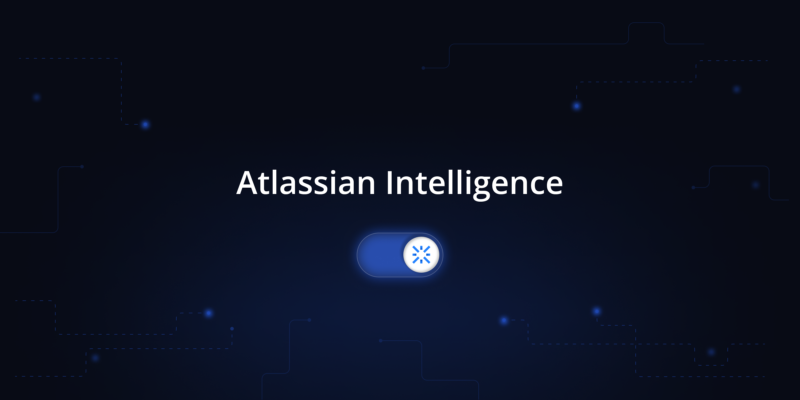
AI in Atlassian Tools – Benefits And Possible Risks
Artificial Intelligence is becoming an integral part of our work. It helps us be more productive by automating tasks, analyzing, and boosting the speed of our work. Due to the desire to accelerate work and make it more efficient, SaaS providers integrate AI into their software.
For example, Atlassian in 2023 announced Atlassian Intelligence, a combination of state-of-art OpenAI models and the power and data within the Atlassian platform. After a year, Atlassian can boast of 20K+ customers who have already used Atlassian Intelligence in beta. So, here we can see that numbers speak for themselves – teams need AI in their daily work. So, let’s figure out what Atlassian Intelligence is and what benefits it brings to its users…
Atlassian Intelligence – what is it?
Using the power of generative AI coupled with Atlassian’s 20 years of teamwork data, the service provider created Atlassian Intelligence aimed at unleashing the potential of every team. This virtual assistant helps teams make their work more efficient and productive. On Team’24, Atlassian said that teams can save over 45 minutes a week on average using AI. Moreover, nearly 80% of Atlassian Intelligence users reported saving time using AI searching functionalities…
So, how does it work? Atlassian Intelligence uses large language models to infer how teams at a given organization collaborate. On its basis, AI builds a personalized collaboration graph where teams can find the different types of work being done and their interconnection. Because of the Atlassian platform’s open approach, teams may also find on this teamwork graph data from the third-party apps they use.
Let’s look at Atlassian Intelligence in action. Well, how can you benefit from it?
- generate and transform content ,
- use AI summaries to summarize an issue’s details, blogs, comments,
- quickly decipher acronyms, jargon, and concepts unique to your organization with AI definitions,
- use natural language to create rules,
- drive teamwork with search issues.
And there are more features to come to accelerate individual, teamwork, and organization-wide productivity.
AI in Atlassian tools
Well, we have already looked at the benefits of Atlassian Intelligence and fairly enough understood what it gives its users. So, is this feature available to any Atlassian user? Nope… for now Atlassian Intelligence is available and automatically activated for all the service provider’s users in Premium and Enterprise plans, though, there are some differences for Bitbucket users. Moreover, it’s up to an organization to decide whether to use Atlassian Intelligence in their work.
Here we are going to focus on Atlassian Intelligence and its features in Jira, Bitbucket, Jira Service Management, and Confluence. However, let’s not forget that Atlassian Intelligence is also available in Trello and Atlassian Analytics.
Atlassian Intelligence in Bitbucket
Starting from April 11, 2024, you can activate the AI feature for Bitbucket Cloud only if you use a Premium plan. However, for those customers of a Free and Standard version, who participated in the AI open beta, the AI features will be available till June 30, 2024. After that, if those Bitbucket users still want to have AI features, they will need to upgrade to a Premium version.
So, what does AI feature in Bitbucket give to its users? Well, with Atlassian Intelligence, Bitbucket users can generate, transform, and summarize their content. It means that with AI, they can create descriptions for their pull requests, use custom prompts to produce comments, and quickly alter the tone of their comments.
Atlassian Intelligence in Jira
With Atlassian Intelligence, Jira users can boost productivity, accelerate their work, and faster understand the context. For example, they can use everyday language instead of complex queries to search for issues. In this case, AI can swiftly identify issues by converting simple prompts into JQL queries.
Among other available AI features for Jira, we should also mention:
- AI automation which allows you to create a rule based on your explanation of requirements or actions you need to automate,
- and the possibility of generating and transforming content when by providing a simple prompt, you can get a draft for issue descriptions and comments. Moreover, you can modify the writing style, change the tone, and simplify technical material with AI, so that every member of your team can easily understand it.
Atlassian Intelligence in Jira Service Management
Probably, the widest range of AI features is available for JSM. Using AI request-type suggestions, JSM users can reduce the time they used to spend on deciding which request types they need to create for the given project. With the feature, all they need to do is to briefly explain their work and how their team usually handles it.
Another feature is AI answers. Without the necessity to create an intent, JSM users can search within their linked knowledge base to answer their customer questions in both Slack and the help center.
Moreover, Atlassian Intelligence in Jira Service Management can:
- suggest fields to users while they build their request forms,
- group related alerts to assist teams in managing alerts and resolving issues more effectively,
- create rules if the JSM users explain requirements or actions they want to automate,
- generate and transform content with the possibility of changing the tone,
- summarize the details of an issue, so that users don’t need to spend their time on reading through long descriptions or comment threads.
Atlassian Intelligence for Confluence
Like using Atlassian Intelligence in JSM, with the help of AI in Confluence, its users can create rules using AI automations, generate and transform content with a simple prompt, and summarize content, though, in the case of Confluence, we speak about pages and blogs.
What’s more, Confluence users can talk to AI. For example, if you search for some info, you can simply ask Confluence and get an instant answer. If there are any company-specific terms, project names, acronyms, or statuses on a Confluence page, Atlassian Intelligence will instantly provide definitions.
And, finally, AI in Confluence summarizes Smart Links, which means that users don’t need to follow the link to find out the information but can quickly read the summary to understand if they need to go to the new page in tab.
Are there any risks?
Atlassian Intelligence can enhance productivity, however, let’s not forget that it is still in the phase of development. It means that there can be some limitations in AI due to numerous factors, including systemic biases, narrow inputs, insufficient training or test data.
Thus, when it comes to critical data, you should be attentive to security measures and data protection to ensure AI doesn’t cause another threat. Do you remember about the Atlassian Cloud Security Shared Responsibility Model? Within it, you, as a user, are responsible for your account data. That’s why ensuring backup and Disaster Recovery can become a cornerstone of your data protection strategy.
Want to be sure that your backup strategy is reliable? Check our Bitbucket backup best practices and Jira backup best practices.
Before you go:
🔎 Don’t miss our series of articles on how to build an effective security strategy – Atlassian security best practices and Jira security best practices
✍️ Subscribe to GitProtect DevSecOps X-Ray Newsletter and always stay up-to-date with the latest DevOps and DevSecOps news
📅 Schedule a live custom demo and learn more about GitProtect backups for your Bitbucket, Jira and Confluence data protection
📌 Or try GitProtect backups for your Bitbucket or Jira ecosystems to guarantee data protection and ensure continuous workflow






